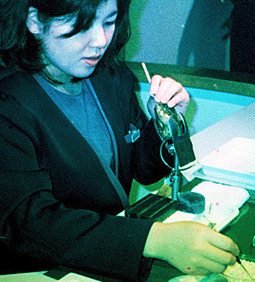
Pearl is unique among gemstones, being the only one found within a living creature, and the only one which requires no fashioning (cutting or polishing) before use. Another distinctive feature is its near exclusive use by one gender. Although some efforts have been made to market pearl jewelry to males in recent years, pearls remain the most "feminine" of all gemstones. Designated officially as the June birthstone, they are, unoffically, a near requirement for brides.
Cultured pearls are those which form in certain mollusks (oysters and mussels) at the intervention of man. Both fresh and saltwater species are used. A shell bead and/or a piece of mantle tissue from another individual is inserted into the interior of the animal. This operation must be done skillfully so that the creature not only survives but accepts the "nucleus". If successful, this process induces the animal to form a "pearl sac" whose cells secrete a layer of brownish protein called conchiolin, (kon-KY-o-lin) over the irritant. This is followed by the secretion of numerous mineral layers of nacre (nay-ker) composed of calcium carbonate (aragonite and/or calcite) in thin overlapping plates.

The composition and structure of this nacre is essentially identical to that which forms under natural conditions. The thin layers create a kind of diffraction grating through which light must pass. This diffraction phenomenon is responsible for the surface pearly luster, and if the layers are sufficiently thick and properly aligned, may result in that most prized of all pearl characteristics, an iridesence, called "orient". High quality pearly luster can be described as a satiny shine or glow that goes deeper than the surface. Orient, when present, is unmistakable and breathtaking: a shifting surface layer of spectral colors from subtle to dramatic, depending on the type and quality of the pearl.

The culturing process in freshwater pearls takes place over a period of from six months to three or more years, depending on the conditions, the species, and the desired outcome. The mollusks that produce freshwater pearls (both natural and cultured) are mussels that live in rivers and streams. Unlike what is standard procedure for saltwater culturing of pearls, beads are rarely used as a nuclei. Instead, the vast majority of FWCP are "tissue nucleated" only. This means that only mantle tissue is used, and that most of the resulting pearl is composed of nacre, rather than only the outer skin, as in the case of bead nucleation.
The various species of fresh water mussels are capable of producing a wider range of natural colors than most saltwater mollusks: from white, cream, yellow, gold, silver, blue and brown to grey. They also grow faster and will tolerate multiple tissue nucleations, so that a harvest of 30-40 pearls from a single animal in 2 years is not uncommon. The slower growing bead nucleated, saltwater types will generally yield only 1 or 2 pearls per animal. It's easy to see why the freshwater types are so much less expensive.
Primary sources of production of freshwater cultured pearls are China, Japan, and the US. The process of commercial production of freshwater pearls originated in Japan at the end of the 1920's at Lake Biwa, but various problems such as pollution and viral diseases have hampered production in recent years. Progress is being made in restoring the ecosystems and breeding resistant mollusks, so we may well see the return of Japanese pearls to a prominent place in the market in the future, especially as a result of recent production at Lake Kasumiga of a lovely pink pearl. At present, however, the premier source is China.
Although once thought of as an inferior product, advances in technique and marketing practices have made today's Chinese freshwater pearl a true gem. Up until the 70's most of the Chinese pearls were small, wrinkled and flat. This earned them the unflattering, but rather descriptive nickname of "rice krispies". These pearls, though not what the public was used to in shape, had to be admired for the depth of luster that being nearly all nacre imparts. Orient, seen only in the finer grades of natural and saltwater cultured pearls was relatively common in these little beauties.
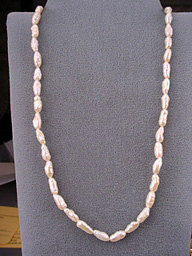
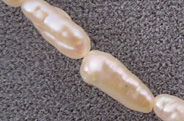
Inexpensive and available in fun and fantastic shapes, these pearls began to command a larger and larger share of the cultured pearl market that was once dominated by saltwater Akoya pearls.

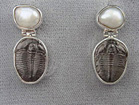


As tissue nucleation techniques were improved, larger and more uniform pearls resulted, and symmetry improved so that pear, oval and egg shapes became available. Today some types are very close to round and getting larger, so that their appearance is rivaling their far more costly saltwater cousins.


A small scale new development in Chinese pearl production is the use of bead nucleation. For the present, this is mostly done under wraps and hush-hush, but there is strong evidence that some of the largest, and roundest of the pearls have been nucleated with either shell beads, as in saltwater pearl production, or with a nucleus made from another FWCP. If you think about this for a second, though: what better material to use? The resulting pearl is large, very round, and almost pure nacre. I for one, would not be averse to owning such a pearl (as long as it's nature was properly disclosed and I paid an appropriate price for it).
The rivers of the East Central US, especially the Tennessee River, have long held a special place in pearl culturing. The shell beads used in such quantity in saltwater production come from the mussels living in these rivers. Although many other species' shells, and indeed, many other materials have been tried, these are still the standard.
The US commands a substantial and growing share of the market with the FWCP produced from these waters, especially, again, the Tennessee River. Unlike the Japanese and Chinese FWCP, the American ones are bead nucleated. The producers take special care and allow the nacre layers to grow for up to five years, producing a superior pearl. They specialize in fancy and fanciful shapes such as sticks, crosses and wildly shaped baroques. Jewelry designers love the artistic possibilities presented by the unique shapes, and pearl connoisseurs love the depth of nacre, especially in the nooks and crannies of the baroques where it pools and creates intense orient. Added to this is the fact that of all the world's cultured pearls, the American FWCP is the only type that is routinely unenhanced, so you can understand why they have a devoted following even with their somewhat higher prices.
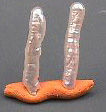

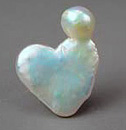
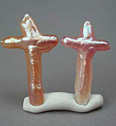
Culturing pearls is a delicate process, not assured of success. Only 25 - 30% of the altered mollusks survive and produce pearls and generally only a small percentage of the pearls harvested are of fine quality. Several factors determine what a particular pearl farmer will do: the longer the pearl grows, the thicker the nacre and the more durable and potentially beautiful it will be, but at the same time, longer cultivation increases the death rate of the animals and the percentage of damaged and misshapen pearls. Different strategies produce pearls of different overall qualities, aimed at different segments of the market. Because the market for inexpensive pearl jewelry is so vast, most producers aim for crops of plentiful medium to lower grade pearls with just a small percentage of them specializing in fewer, higher quality pearls.
Enhancements are so common that unless it is specifically stated by the seller, you should assume a FWCP has been at least bleached to remove dark spots of conchiolin which show through the nacre. Most have also been tumble polished to improve surface shine and remove bumps. More dramatic techniques such as dyeing or irradiation produce pearls with exotic colors such as green, black, bright gold and purple.
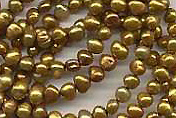
Faux pearls have been around for a long time and can consist of a variety of materials such as glass, plastic or shell with various surface treatments meant to simulate the pearl's luster. The time honored standard material is a lacquer containing an ingredient from ground fish scales called "pearl essence" or "essence d'orient".
With FWCP prices at historic lows, there is little incentive to buy or wear imitations. A rule of thumb when testing a suspect pearl, is to rub it across the surface of your teeth. Pearls with a nacre surface (natural or cultured) will feel slightly gritty, most imitations will feel smooth.
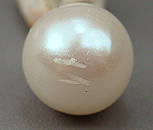
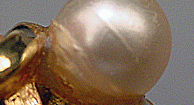
Although pearls are delicate, they have been successfully used in jewelry for thousands of years. As they are sensitive to heat, chemicals and abrasion, they should be stored in a cloth bag or their own box away from contact with other materials. They should be protected from chemicals such as hairspray and perfume and chlorinated water.
Wiping them with a damp cloth after wearing, and occasional cleaning in mild soapy water is all that's required. Under no circumstances should they be placed in an ultrasonic or steam cleaner. Jewelry settings in rings and bracelets should be protective, or if not (as in many pearl rings) the piece should be considered for occasional use only, rather than daily wear.
FWCP are a bargain. This is especially true as the quality rises, they are far less expensive than similarly sized saltwater pearls and have their own distinctive beauty.
The value of any pearl is most related to the thickness and quality of the nacre. A pearl with thin nacre cannot be deeply lustrous or have orient, but not all thick nacred pearls will exhibit those traits either. The thinness, translucency and alignment of the nacre platelets determine its quality.
Those with deep luster and visible orient are most desirable. Other factors include size (especially in rounds), shape, and color. In general the highest prices will be paid for large, round, well colored, unenhanced gems. Factors which influence value in pearl jewelry pieces would add to these general considerations, quality of stringing and degree of matching in size and color.